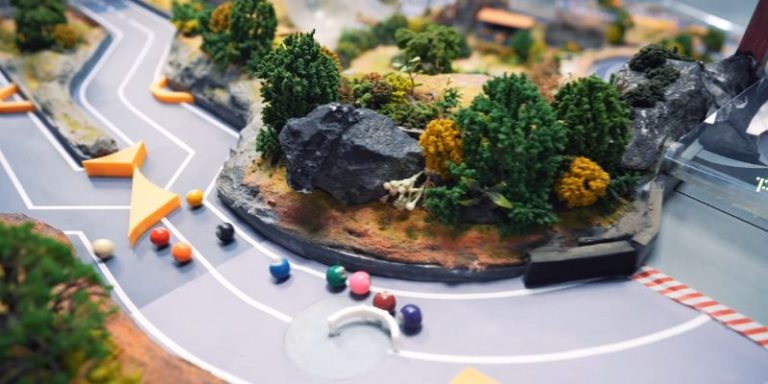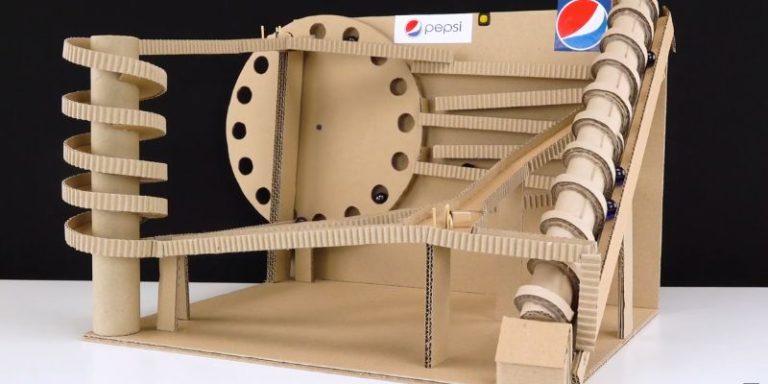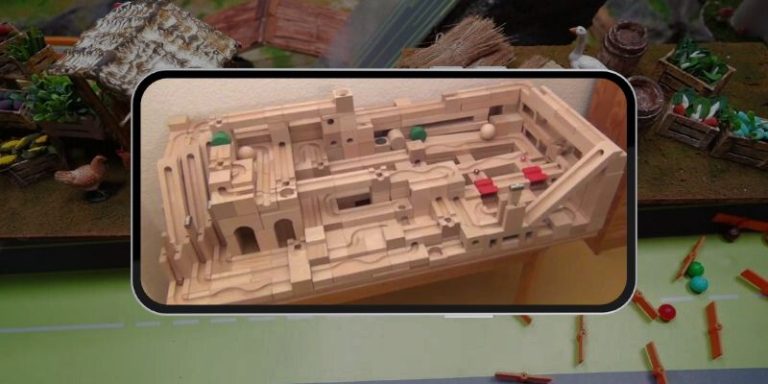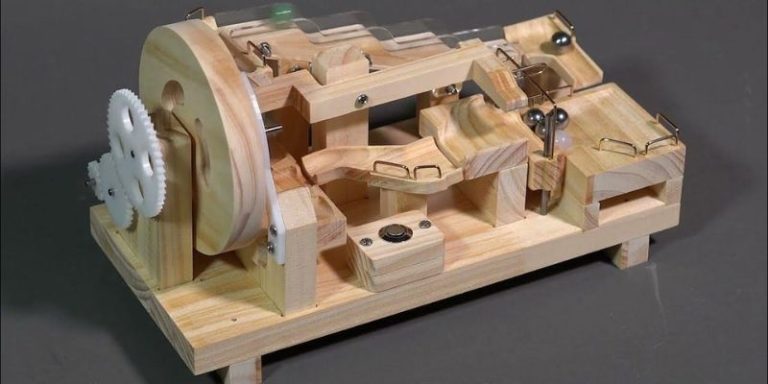How does a marble race track work? A fun & Simple guide
A marble race track uses gravity to move marbles along a predetermined path, complete with slopes, twists, and obstacles. As the marbles roll, momentum and track features like funnels, ramps, and barriers generate excitement and unpredictable results. The surface material, track arrangement, and marble type all influence speed and control. Whether homemade or professionally built, these tracks bring exciting races to life!
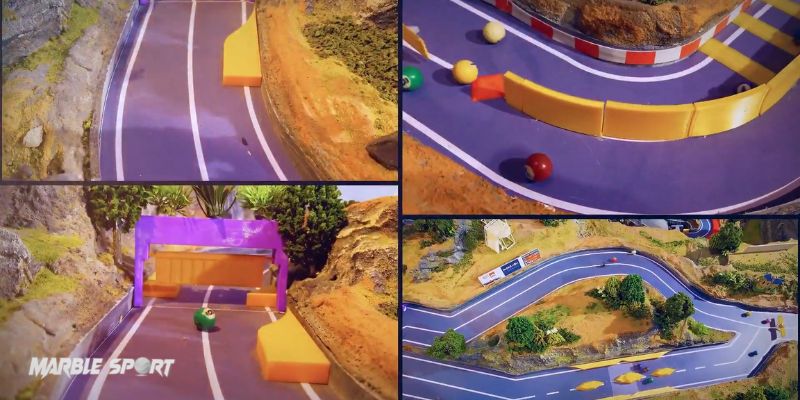
The basics of a marble race track
Marble race tracks may appear basic, but they use physics, track design, and obstacles to produce interesting and unpredictable races. Here’s a breakdown of the key components that make a marble race track work:
Starting Mechanism: How the Race Begins
Every race requires a fair start, and there are various methods to release marbles:
- Automatic Gates – Used in professional tracks such as Marble Magic, these gates drop all marbles simultaneously to ensure a synchronized start.
- Ramps and Slopes – A bare slope allows marbles to roll down naturally, increasing speed.
- Hand Releases – A simple but effective approach to starting a race by raising a barrier and allowing the marbles to roll freely.
A well-designed start creates an equal playing field, allowing marbles to compete without unfair advantages.
Track Surface
The material of the track has a significant impact on how marbles move:
Plastic tracks are smooth and fast, perfect for regulated races with modular track parts.
- Wooden Tracks – Sturdy and natural in texture, providing a solid hold for marbles.
- Cardboard Tracks – An excellent DIY alternative; however, friction may slow marbles down.
- Sand Tracks – Used in outdoor races to provide an unpredictable and lumpy environment.
Depending on the level of friction and resistance, using the correct surface might make a race faster or more strategic.
Marble Motion
Marbles move based on gravity, requiring slopes and ramps for proper movement.
- Momentum helps marbles retain their speed, especially on smooth and straight stretches.
- Track layout affects racing dynamics; tight corners slow marbles down, whilst lengthy straights let them accelerate.
- Obstacles such as funnels, bumpers, and moving gates add to the challenge, guaranteeing that no two races are identical.
Understanding these fundamentals will allow you to observe how each component affects the race, from the starting gate to the surface material. Ready to get into the fascinating specifics of obstacle and track design? Let’s keep going!
Key components that make a track work
A marble race track is more than just a straight course; its design influences how interesting and unpredictable the race will be. From steep hills to challenging hurdles, each feature influences the outcome. Let’s look at the essential components that make a marble race track come to life.
Ramps & Slopes: Speed Boosters
Ramps and slopes are the backbone of every track, allowing marbles to accelerate by gravity.
- Steeper ramps enable faster beginnings, which is ideal for spectacular launches.
- Gradual slopes allow marbles to gain velocity over extended distances.
- Multi-level drops create excitement, causing marbles to rush from one region to another at rapid speeds.
Marbles would lack the impetus required for an exciting race without well-placed ramps.
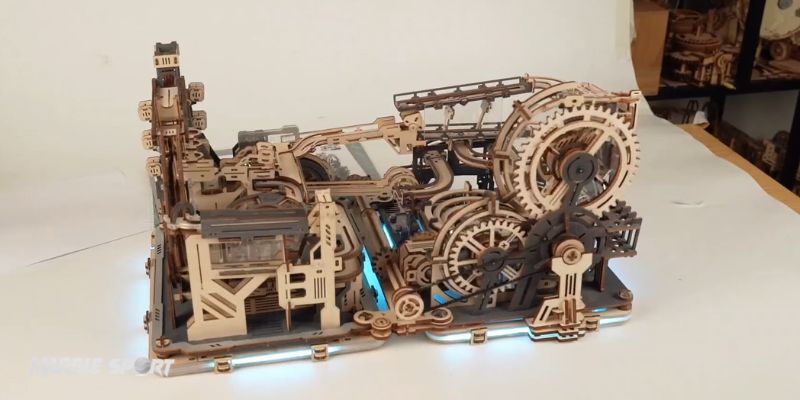
Curves & Chicanes: Testing Control
Not all tracks are designed for speed; certain parts need accuracy and adaptation.
- Marbles can sustain momentum thanks to their wide curves.
- Sharp turns cause marbles to slow down, making positioning important.
- Chicanes (zig-zag sections) force marbles to make fast directional changes.
These elements evaluate a marble’s capacity to withstand twists and bends without spinning out of control.
Obstacles & Hazards
Obstacles make races more enjoyable by adding randomization and challenge.
- Spinning Gates – Rotate to prevent or allow entrance at unpredictable moments.
- Bumpers and barriers can knock marbles off course or cause them to shift directions.
- Funnels – Arrange marbles in a tight space before dropping them into the next segment.
- Jumps and Gaps – Successful landings require precisely the proper amount of speed.
The greatest tracks strike a mix of speed and obstacles, making each race unique.
Lifts & Loops: Extending the Race
Some tracks, including vertical movement and risky exploits, go beyond a single run.
- Lifts (manual or motorized) transport marbles back to the top during multi-lap races.
- Loops and spirals enhance the spectacle by needing enough momentum for marbles to complete the revolution.
- Drop Towers produce unexpected free-fall moments before launching marbles into the following section.
These innovative elements make races feel more dynamic and unpredictable, keeping viewers on the edge of their seats.

The science behind marble racing
Marble racing is more than just rolling marbles down a track; it’s a physical war! Gravity, momentum, friction, and even collisions contribute to how a marble moves. Let us break it down.
Gravity & Momentum
Gravity pulls marbles downhill, so slopes and ramps are crucial for acceleration. The steeper the track, the faster the marble accelerates. Momentum keeps the stone rolling—once it starts moving, it wants to keep going unless something stops it.
Friction & Surface Material
Not all tracks are equal! Smooth plastic or polished wood has less friction, allowing marbles to slide faster. Rough surfaces, such as sand or cardboard, increase resistance and slow them down. A marble’s speed is affected by its weight and substance; heavier stones roll more slowly.
Collisions & Randomness
A well-placed barrier, bumper, or bend can completely alter a race. Marbles clash, bounce wildly, and occasionally become lodged. Track design is essential; abrupt corners slow marbles down, whilst wide curves allow them to retain speed. That is what makes each race unique!
Different types of marble race tracks
Not all marble race tracks are the same! The track style can dramatically alter marble’s operations, giving each race excitement and unpredictability. Let’s take a look at some of the most popular track styles.

Traditional Tracks
Traditional tracks include plastic modular sets and homemade cardboard creations.
- Modular plastic tracks snap together, providing smooth bends and fast runs.
- DIY cardboard tracks are simple to make and allow for limitless creativity.
- Both approaches are ideal for controlled, consistent racing with low randomness.
These tracks are ideal for beginners and casual racers seeking entertaining and competitive action.
Sand Tracks
Sand-based circuits provide a wild, off-road feel in marble racing.
- The natural terrain changes with each race, making the results unpredictable.
- Marbles burrow into the sand, requiring weight and stability to remain on track.
- Tracks can be constructed into hills, valleys, and bends to resemble real-world race courses.
Sand tracks are suitable for outdoor marble races and endurance competitions.
High-Speed Tracks
High-speed tracks are engineered for optimum acceleration with little friction.
- Marbles roll well on smooth plastic or polished wood surfaces.
- Steep slopes and lengthy straights allow for quick acceleration.
- Banked bends allow marbles to keep their velocity without losing control.
These tracks evaluate a marble’s aerodynamics and weight balance, rewarding the fastest designs.
Obstacle Courses
Obstacle tracks increase chaos and strategy, making races more thrilling and unpredictable.
- Jumps and ramps challenge a marble’s momentum.
- Moving gates, spinning wheels, and bumpers add randomization.
- Narrow pathways and chicanes necessitate accuracy and control.
These tracks are ideal for people who prefer high-stakes, adrenaline-fueled racing where anything can happen.
FAQ about marble race track work
How can I make a marble run STEM project for school?
Use ramps, tubes, and obstacles to demonstrate motion, gravity, and speed.
Are there marble tracks for adults?
Yes. Hobbyists build complex tracks with lifts, motors, and race systems for speed and challenge.
Why do marbles go faster on steeper slopes?
Steeper slopes increase gravitational pull, creating more acceleration.

